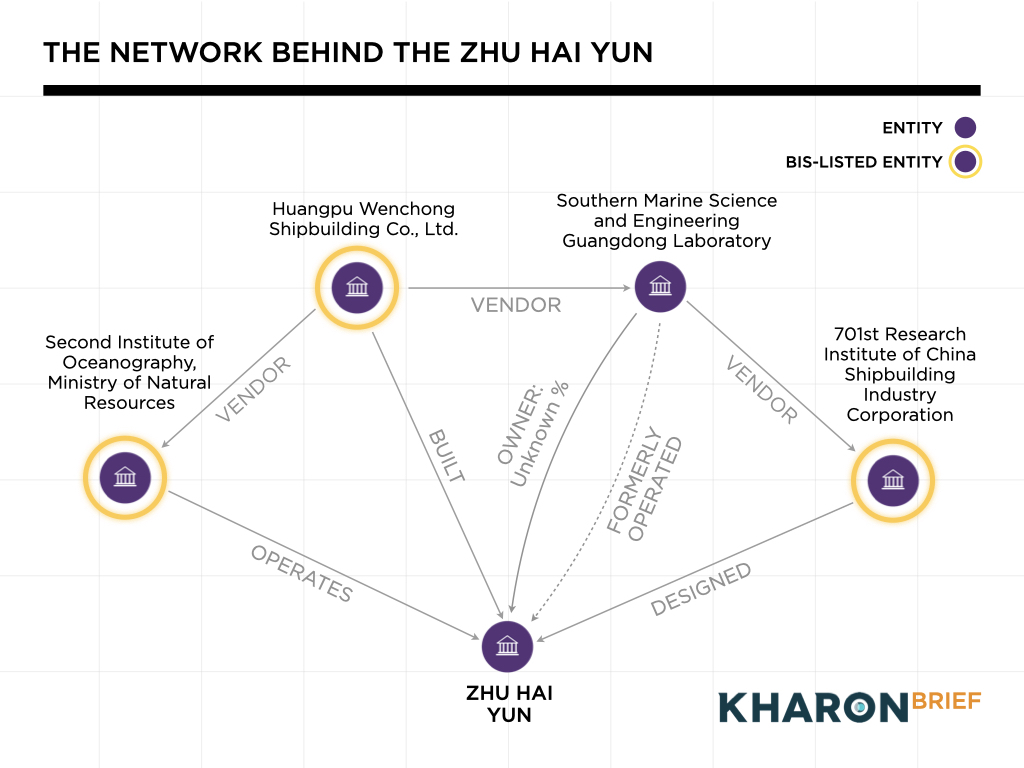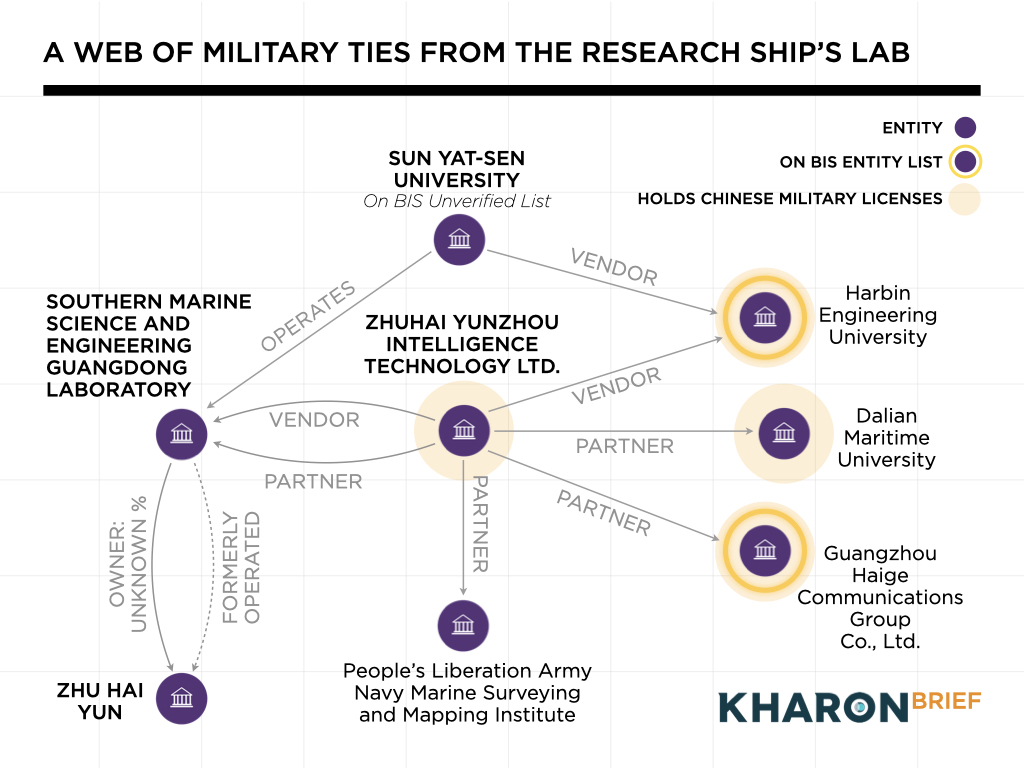The Zhu Hai Yun—a ship that China describes as the world’s first civilian drone carrier for ocean science—triggered sharp warnings last month when it operated in a Philippine sea zone without authorization.
The 88.5-meter vessel is designed to deploy more than 50 aerial, surface and underwater drones, which together can conduct three-dimensional reconnaissance across a range of nearly 100 miles. The Philippine Coast Guard said it suspected the Zhu Hai Yun of “engaging in illegal marine scientific research” in the country’s Exclusive Economic Zone and that the ship “has significant military dual-use potential, including mapping submarine routes and deploying smart mines.”
That international incident was just the latest for the research ship, following an October 2023 expedition that experts saw as a challenge to Taiwan. And a Kharon investigation shows that the Zhu Hai Yun’s military ties are far more than theoretical.
The 88.5-meter vessel is designed to deploy more than 50 aerial, surface and underwater drones, which together can conduct three-dimensional reconnaissance across a range of nearly 100 miles. The Philippine Coast Guard said it suspected the Zhu Hai Yun of “engaging in illegal marine scientific research” in the country’s Exclusive Economic Zone and that the ship “has significant military dual-use potential, including mapping submarine routes and deploying smart mines.”
That international incident was just the latest for the research ship, following an October 2023 expedition that experts saw as a challenge to Taiwan. And a Kharon investigation shows that the Zhu Hai Yun’s military ties are far more than theoretical.

The unmanned Chinese research vessel Zhu Hai Yun is spotted near Balagtas Reef on July 31, after leaving Guangdong, China, on June 23 and entering the Philippines’ Exclusive Economic Zone on July 25. (Philippine Coast Guard)
According to a review of corporate filings, procurement records and government documents, the ship and its academic owner connect to an expansive military-industrial network. It includes numerous entities targeted by the U.S.—starting with those responsible for the construction of the Zhu Hai Yun itself.
The direct links
- According to registration records and state-owned CCTV, the ship’s designer was the 701st Research Institute of China Shipbuilding Industry Corporation. The U.S. Bureau of Industry and Security (BIS) named that institute to the Entity List in 2022 for “acquiring and attempting to acquire U.S.-origin items in support of China’s military modernization efforts.”
- The ship’s registered builder, Huangpu Wenchong, is a naval shipbuilder that BIS named to the Entity List in 2020. The stated reason is relevant: BIS cited Huangpu Wenchong’s involvement in “China’s efforts to assert its unlawful maritime claims in the South China Sea, as well as efforts to intimidate and coerce other coastal states from accessing and developing offshore marine resources.”
- Registration records list the Zhu Hai Yun’s current operator as the Second Institute of Oceanography, Ministry of Natural Resources, which BIS named to its Military End-User List in 2020. That list restricts imports and exports on certain items because of “an unacceptable risk of use in or diversion” for military use.

But it’s the Zhu Hai Yun’s owner and former listed operator, the Southern Marine Science and Engineering Guangdong Laboratory, that opens up a sprawl of additional military connections.
The laboratory is a campus facility owned by the Zhuhai municipal government and run by Sun Yat-sen University (SYSU). The U.S. spotlighted SYSU’s military connections in 2015, when it named the university’s National Supercomputing Center to the Entity List for hosting the Tianhe-2 supercomputer, which BIS said was “believed to be used in nuclear explosive activities.”
According to bidding documents, SYSU continued to compete for People’s Liberation Army (PLA) contracts through at least 2023. The Southern Marine Laboratory promotes on its website both the Zhu Hai Yun and the Tianhe-2 supercomputer as key research tools. The lab says its mission includes facilitating China’s transformation into “a strong maritime power.”
And it has a key partner in that work.
While Zhuhai Yunzhou Intelligence’s website emphasizes commercial applications such as “smart water management, marine engineering, and public safety,” the company also holds a PLA-issued license permitting the production of items for military use. Records show that it has taken part in procurement bids organized by the Chinese military, and the state-run Economic Daily reported in 2018 that Zhuhai Yunzhou Intelligence had rolled out a series of unmanned military vessels since 2014.
The laboratory is a campus facility owned by the Zhuhai municipal government and run by Sun Yat-sen University (SYSU). The U.S. spotlighted SYSU’s military connections in 2015, when it named the university’s National Supercomputing Center to the Entity List for hosting the Tianhe-2 supercomputer, which BIS said was “believed to be used in nuclear explosive activities.”
According to bidding documents, SYSU continued to compete for People’s Liberation Army (PLA) contracts through at least 2023. The Southern Marine Laboratory promotes on its website both the Zhu Hai Yun and the Tianhe-2 supercomputer as key research tools. The lab says its mission includes facilitating China’s transformation into “a strong maritime power.”
And it has a key partner in that work.
The corporate bridge
The Southern Marine Laboratory has developed an extensive patent partnership, Kharon’s investigation found, with Zhuhai Yunzhou Intelligence Technology, a company located nearby. The two hold at least 10 joint patents, including related to UAV deployment, unmanned submersibles and cluster tasks, which involve multiple drones working together like the Zhu Hai Yun’s.While Zhuhai Yunzhou Intelligence’s website emphasizes commercial applications such as “smart water management, marine engineering, and public safety,” the company also holds a PLA-issued license permitting the production of items for military use. Records show that it has taken part in procurement bids organized by the Chinese military, and the state-run Economic Daily reported in 2018 that Zhuhai Yunzhou Intelligence had rolled out a series of unmanned military vessels since 2014.

The Zhu Hai Yun was designed to deploy dozens of aerial, surface and underwater drones, which together can cover a three-dimensional range of nearly 100 miles. (China State Shipbuilding Corporation)
The company has at times been transparent about such collaborations.
In a 2018 interview published by a Beijing think tank, Zhuhai Yunzhou Intelligence’s founder, Zhang Yunfei, called the firm a “model of military-civil fusion,” boasting that its products were designed to “lead the military with civilian innovation.” Meanwhile, Zhang is directly tied to the ship-owning Southern Marine Laboratory himself: Its website lists him as the lab’s “Chief Scientist,” a position that Chinese media reporting suggests he’s held since at least 2022.
In a 2018 interview published by a Beijing think tank, Zhuhai Yunzhou Intelligence’s founder, Zhang Yunfei, called the firm a “model of military-civil fusion,” boasting that its products were designed to “lead the military with civilian innovation.” Meanwhile, Zhang is directly tied to the ship-owning Southern Marine Laboratory himself: Its website lists him as the lab’s “Chief Scientist,” a position that Chinese media reporting suggests he’s held since at least 2022.
Connecting the dots
Before and throughout its partnership with the lab, Zhuhai Yunzhou Intelligence struck other partnerships with the Chinese military and a string of military end-users.
Kharon found that the company:
The bottom line
China’s pursuit of underwater drone technology appears to reflect broader strategic calculations beyond solely civilian applications. The Zhu Hai Yun project demonstrates how academic research can provide cover for a web of military-industrial collaborations, just beneath the surface.
More from the Kharon Brief:
- worked with the PLA Navy Marine Surveying and Mapping Institute on a joint project in Antarctica in 2017.
- supplied unmanned ships and systems to Harbin Engineering University, one of Beijing’s designated key feeder universities for the military and defense industry. The U.S. imposed sanctions on Harbin Engineering University in 2020, and Canada followed suit in 2024. Both cited the university’s role in supporting China’s military modernization through research and development activities.
- holds a 2020 patent on data processing, transmission and unmanned equipment with Guangzhou Haige Communications Group, a company the U.S. added to the Entity List in 2020 for its involvement in China’s “land reclamation activities in the South China Sea.”
- holds another patent, dated this year, with Dalian Maritime University, that focuses on “swarm” technologies for tracking moving targets in complex environments—a critical aspect of naval warfare development. Dalian Maritime possesses licenses to engage in weapons research and development for the PLA.
The bottom line
China’s pursuit of underwater drone technology appears to reflect broader strategic calculations beyond solely civilian applications. The Zhu Hai Yun project demonstrates how academic research can provide cover for a web of military-industrial collaborations, just beneath the surface.More from the Kharon Brief:







